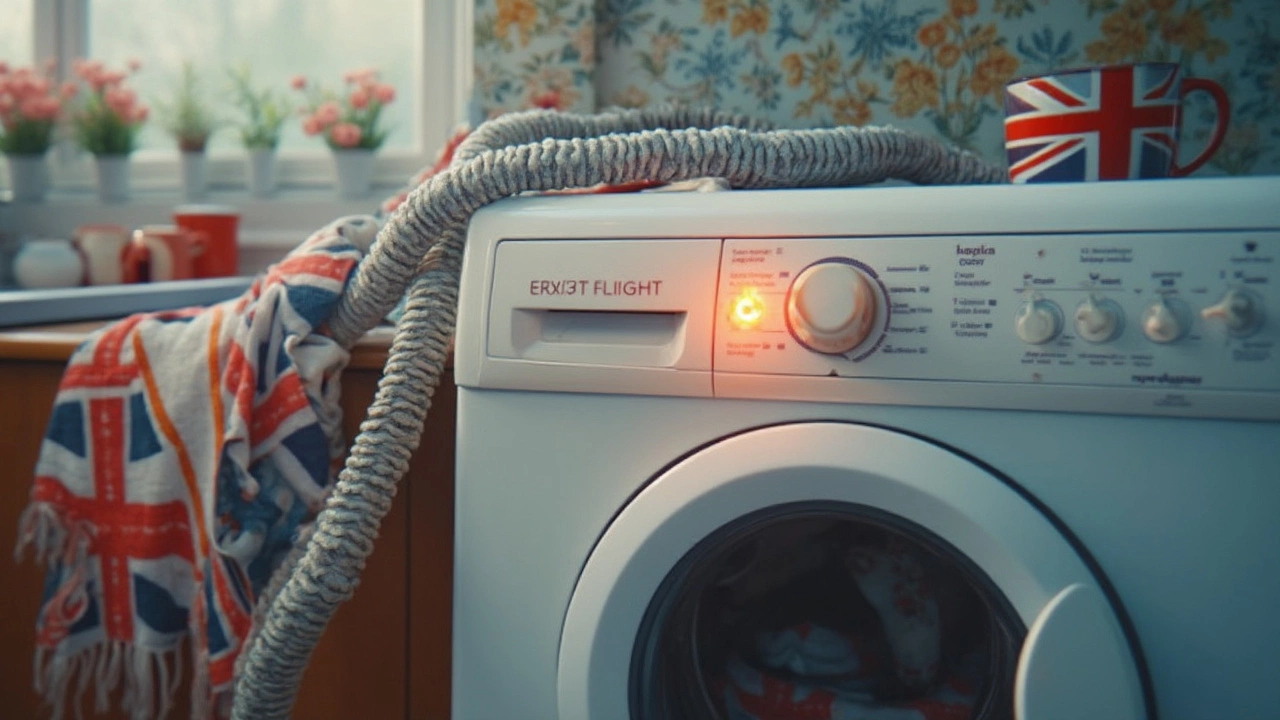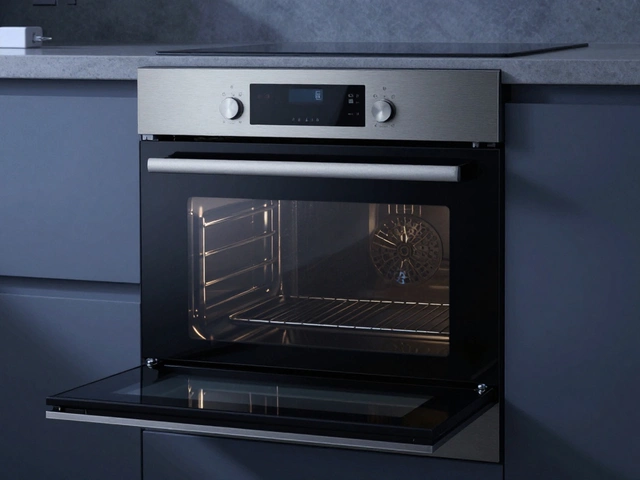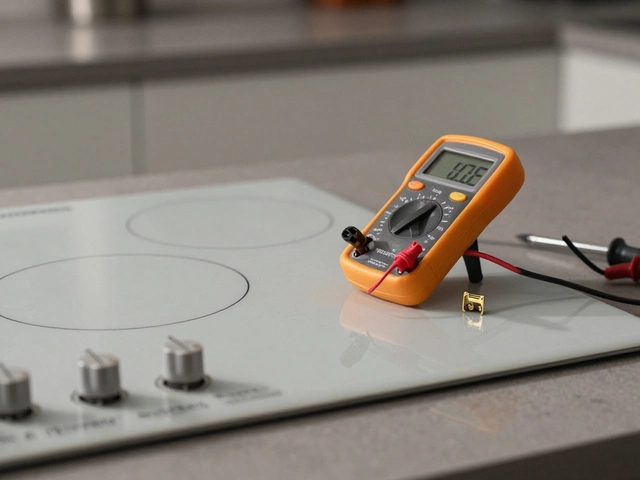Your washer suddenly refuses to start, no matter how many times you jab the buttons? That’s not just bad luck—most of the time, it’s the door or lid switch failing. This tiny part is like a gatekeeper; if it thinks the door is open, it stops everything cold for safety.
Loads of people end up buying a whole new machine when it’s just this small switch acting up. Before you panic or call for help, it’s good to know what this thing does and why it’s the number one source of grief.
This problem shows up in both front loaders and top loaders. And here’s something useful: if your machine refuses to spin or start, don’t jump to blaming the motor or the controls. Check the latch or switch first. Nine times out of ten, that’s your culprit.
- The Most Frequent Culprit: Broken Door or Lid Switch
- Why the Switch Fails
- How to Spot the Problem
- Quick DIY Fixes You Can Try
- When to Call a Pro
- Keeping Your Washer Running Longer
The Most Frequent Culprit: Broken Door or Lid Switch
Out of all the things that can go wrong with a washing machine, nothing trips people up more often than a broken door or lid switch. These switches are super basic, but your washer won’t do anything without them working right. Manufacturers put them in there as a safety thing—it keeps the machine from running with the door open, which could soak your laundry room or even hurt someone.
Here’s what you need to know: on a front loader, the door switch is usually tucked away just inside the door, and on a top loader, the lid switch hangs out under the lid. When you shut the door or lid, the switch gets pressed and tells the machine everything’s safe to go ahead. If that switch doesn’t click in, the machine just sits there. No spinning, no draining, nothing. It might even act totally dead.
This is by far the most common problem in washing machine repair. In fact, some repair techs say they swap out hundreds of these little parts every year. Over time, switches just wear out from all the opening, closing, and slamming. Sometimes, a family with rowdy kids (or a rushed morning routine) goes through these switches even faster.
If you’ve ever noticed your machine tunelessly ignoring you, not unlocking at the right time, or refusing to spin, the door switch should be the first thing on your checklist. It’s just a tiny part, but without it, your washer basically turns into a really expensive laundry basket.
Why the Switch Fails
If you’re scratching your head, wondering why this little switch causes so much trouble, you're not alone. The lid or door switch takes a beating every single laundry day. It's built to sense if the door is shut, making sure the machine only runs when it's safe. But all that snapping and pressing? Over time, it wears out.
You might be surprised how many times you open and close your washer during its life. An average family uses their machine up to 400 times a year. That's hundreds of times the switch gets clicked and unclicked—no wonder it gives out!
Here's a quick breakdown of what leads to switch failure:
- Washing machine repair techs will tell you: wear and tear is the main offender. Years of slamming the lid or pulling on a stuck door can crack the plastic or bend the tiny metal bits inside the switch mechanism.
- Moisture is another big culprit. Washers live in steamy rooms and water can sneak in, causing corrosion or sticky buildup on the switch's contacts.
- Kids leaning or sitting on the lid (guilty as charged in my own house), or heavy items dropped on the washer, can snap the latch or shift the alignment, so it doesn’t click right anymore.
- Sometimes detergent leaks or fabric softener drips down the inside of the machine and gums up the works. You’d be surprised how fast residue builds if you use a heavy hand with the soap.
Take a look at this simple table to see what usually causes switch failure:
| Cause | How Often? | Quick Fix? |
|---|---|---|
| Normal Wear | Very common | Replace switch |
| Moisture/Corrosion | Common in humid areas | Clean or replace |
| Physical Damage | Moderately common | Realign or replace |
| Detergent/Fabric Softener Residue | Less common but increasing | Clean contacts |
If your washer suddenly refuses to start, odds are one of these triggers knocked out the switch. It’s nothing fancy—just everyday use adding up, or a little accident you didn’t notice at the time.
How to Spot the Problem
You don't need to be a repair pro to figure out if the door or lid switch is causing your headache. Most washing machines give obvious signs when this part quits working.
- Washer won’t start: You push start, the lights might come on, but nothing happens. Not even a click or hum. This is the classic sign.
- It won’t spin or drain: Sometimes the machine fills with water, but then it just sits there. No spinning, no draining, nothing.
- Lid or door error message: Newer machines often flash a message like “lid open” or “door unlocked,” even if you've slammed it shut five times. That’s usually the switch acting up, not your imagination.
If you want to double check, most washers will let out a quiet click when you close the lid or door and the switch engages. If that click has disappeared, or you have to slam the lid extra hard to get it to register, that’s a big clue the switch is toast.
Here's a quick rundown of how common this issue is compared to others:
| Washing Machine Problem | Reported Frequency (%) |
|---|---|
| Door/Lid Switch Failure | 28 |
| Drain Pump Issues | 19 |
| Control Board Problems | 13 |
| Belt or Drive Issues | 11 |
Out of all the washing machine repair calls made, almost 1 out of 3 are about this switch. So, you’re not alone if you’re seeing these symptoms. Grabbing a flashlight and looking under the lid—sometimes you’ll spot a broken plastic tab, metal bits out of place, or even a snapped wire on the switch. If it looks off, you’ve probably found your problem.

Quick DIY Fixes You Can Try
If your washer’s acting up, don’t rush to replace it yet. Most door or lid switch issues can be sorted out without special tools or much time. Seriously, fixing the washing machine repair problem at home? It’s easier than you’d think.
- Unplug Your Washer: First thing—always unplug before you poke around. Safety matters more than saving a few minutes.
- Find the Switch: For top loaders, it’s usually under the lid where the door touches the body. Front loaders often hide it along the latch inside the door frame.
- Look for Obvious Problems: Sometimes the switch gets sticky from soap build-up or gunk. Clean it off with a cloth and a bit of rubbing alcohol.
- Wiggle Test: Gently press or wiggle the switch. If it feels loose or doesn’t click, that could be your problem right there. These switches are supposed to make a firm little popping sound.
- Check Wires: Wires can get knocked loose, especially if kids have been rough with the washer door (I’ve seen it firsthand at home). Make sure the wire connectors are snug.
- Bypass (Temporary Test Only!): Some folks try bypassing the switch just to test if the machine starts up. Only do this if you understand what you’re doing, and never run a full cycle with the switch bypassed. It’s risky and just for diagnosis.
If you spot a broken switch or dangling wire, replacements cost about $10–$25 online. With most brands, you’ll only need a Phillips screwdriver. Most repairs take less than 20 minutes.
| Washer Brand | Avg. Switch Cost (USD) | Difficulty Level | Time Needed |
|---|---|---|---|
| Whirlpool | 15 | Easy | 10-15 min |
| Samsung | 20 | Medium | 15-25 min |
| LG | 18 | Easy | 10-15 min |
| GE | 12 | Easy | 10 min |
One last thing: switches rarely die out of nowhere. If it happened again soon, maybe too much force is being used when shutting the door, or the alignment is off. It’s worth checking the latch alignment while you’re at it.
When to Call a Pro
Alright, so you’ve checked the door or lid switch, maybe even tried replacing it. Still having problems? This is where calling a washing machine repair pro pays off—especially if you’ve got no luck with the basic stuff, or things seem riskier than you thought.
If your washer hums but won’t spin, or the door just won’t unlock (front loaders love to pull this one), you might be looking at a control board, motor, or wiring problem. Messing with electrical parts is risky business, and that’s best left to someone with the right tools—and insurance.
Also, if you smell anything burning, hear loud popping or grinding noises, or spot water pooling under the washer, do not keep running the machine. Those can mean bigger issues like a blown fuse, a fried motor, or a busted hose. Trying to fix these without training could make things worse or even dangerous.
- If your washer is still under warranty, don’t tinker—let the manufacturer’s service handle it so you don’t lose coverage.
- If you’ve got a high-end washer with touchscreens and sensors, they’re far more delicate. DIY repairs can mess up those expensive electronics.
- When you can’t figure out what’s actually broken, or if you feel out of your depth, that’s the time to get help. A good tech will spot the real issue way faster, saving you hours of frustration.
The cost to hire a pro seems steep, but blowing up a hundred-dollar part or voiding the warranty can end up worse. When you’re unsure, trust the experts—they see washing machine repair problems every day, and most fixes are cheaper than buying a new washer.
Keeping Your Washer Running Longer
If you want your washing machine to stick around for more than a handful of years, regular care is where it’s at. Most washers are built to last 10–13 years, but lack of maintenance can make that number drop fast. Believe it or not, the things that really matter are simple and quick to do, even if you’re new to appliances.
Here are some habits to keep your washer out of trouble:
- Don’t overload the drum. Stuffing it full wears out the motor, the bearings, and especially that lid or door switch we talked about. Split heavy loads to save your machine.
- Use the right amount of detergent. High-efficiency models just need a little. Too much soap leads to gunk and buildup in hoses or on switches.
- Clean the lint trap or drain filter every couple of weeks. Leftover lint can block water flow and stress out the pump.
- Leave the door open after a wash to let things dry out. This stops mold, which can damage seals and the door switch area.
- Give the door switch and latch a wipe every month. A rag with a squirt of all-purpose cleaner is enough to keep grime from making things sticky.
Here's a look at the most common causes for washer breakdowns based on service call records:
| Washer Failure Cause | Share of Service Calls (%) |
|---|---|
| Door/Lid switch issues | 27 |
| Drain problems (clogs, pump) | 18 |
| Water inlet valve problems | 15 |
| Motor failures | 11 |
| Electronic/control board faults | 10 |
| Other (belts, leaks, bearings, etc.) | 19 |
Want to go the extra mile? Every six months, run an empty hot cycle with a cup of white vinegar to clean the inside and hoses. Also, check and tighten the machine’s hoses—loose connections are a big cause of leaks. These little things help you avoid the most common washing machine repair headaches and keep your laundry routine smooth.





